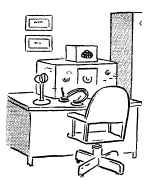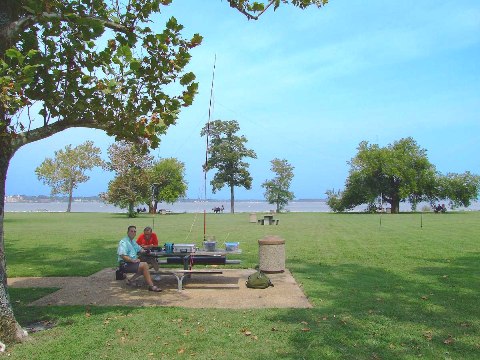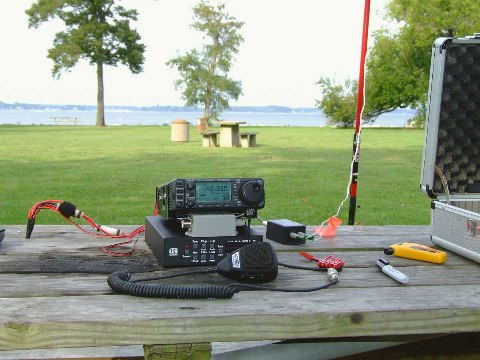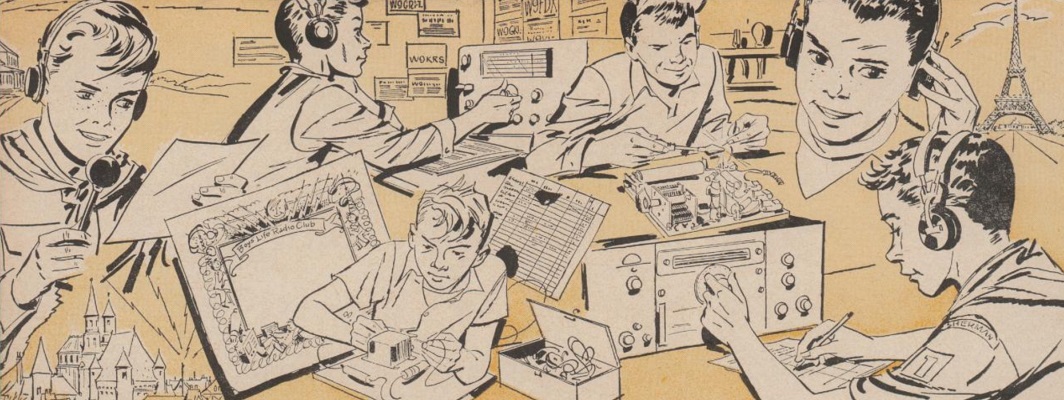 Went up to the Yorktown Battlefield Saturday and linked up with Mark, N1LO. I got to see his portable setup. He was using a delta loop antenna made of speaker wire, maybe about 25′ per side. The speaker wire was in three sections, the sections were connected using fishing line lure links. The speaker wire was terminated using banana plugs and fed into a 1:1 balun. To support the legs of the delta loop, Mark used a combination of a painter’s pole and a fiberglass fishing rod secured by a 3′ picket easily driven into the ground about 8″.
Went up to the Yorktown Battlefield Saturday and linked up with Mark, N1LO. I got to see his portable setup. He was using a delta loop antenna made of speaker wire, maybe about 25′ per side. The speaker wire was in three sections, the sections were connected using fishing line lure links. The speaker wire was terminated using banana plugs and fed into a 1:1 balun. To support the legs of the delta loop, Mark used a combination of a painter’s pole and a fiberglass fishing rod secured by a 3′ picket easily driven into the ground about 8″.

The fiberglass fishing pole’s end easily nests into the painter’s pole with about 6″ overlap raising the loop to a height of about 20′. The painter’s pole was secured to the picket using two small hose clamps. The delta loop tuned easily from 80M to 10M, but would not tune 160M. All the antenna components compacted down to fit into a plastic rifle case. Mark connected the delta loop to his IC-706MKIIG through his LDG AT-200 Pro autotuner and was easily making QSOs into Ohio (the Ohio QSO Party was underway). Power was provided by a ~100aH marine battery and a nice homebrew PowerPole distribution hub. The best part of the setup was the location – in a very nice, shady park on the southern banks of the York River.

In an endeavor to consolidate my 2M packet operations (APRS, Winlink 2K, and good ol’ fashion BBS packet) into the garage, I spent a good chunk of time pushing around boxes and crates. I purchased three 3′ high bookshelves from Target, arrayed them in an open “U” and then placed a 4’x6′ piece of plywood across the top. I filled the bookshelves with back issues of QST and equipment awaiting to be put into use. Next to this workbench, I put a previously unused, small table where I positioned my monitor and PC. I spent the late afternoon converting the PC from Ubuntu back to Window XP (… I can’t commit the time needed to tweak Unbuntu to my needs). Now I need to move the my KPC-3+ from the radio room out to the garage and see if I can get a basic packet station operational.
Also been preparing for the upcoming RV DXpedition. I’ll be taking the ARSIB along with the vertical dipole, but was also thinking about taking a G5RV. I’m also going to try and use a 75M hamstick, we’ll see how that works out.




 Wow! Day one is over – a total of 78 contacts to include two new states for me… Nebraska and Delaware. Worked a number of other states as well to include Washington, Texas, Iowa, Illinois, Ohio, Alabama, Florida, Georgia, New York, New Jersey, Vermont, New Hampshire, Maine, North Carolina, Missouri, Kansas, Connecticut and Pennsylvania. Also a few into Canada.
Wow! Day one is over – a total of 78 contacts to include two new states for me… Nebraska and Delaware. Worked a number of other states as well to include Washington, Texas, Iowa, Illinois, Ohio, Alabama, Florida, Georgia, New York, New Jersey, Vermont, New Hampshire, Maine, North Carolina, Missouri, Kansas, Connecticut and Pennsylvania. Also a few into Canada. On Sunday I headed out to Fort Monroe and activated the Old Point Comfort Lighthouse with limited success. About 4 hours on the air and two contacts. The first contact was Colorado, a loud, booming 59. The next was Virginia Beach…. about 5 miles across the water. I need to come up with a better plan than my hamstick vertical. I’d like to do the next activation during Amateur Radio Military Appreciation Day coming up on Memorial Day weekend.
On Sunday I headed out to Fort Monroe and activated the Old Point Comfort Lighthouse with limited success. About 4 hours on the air and two contacts. The first contact was Colorado, a loud, booming 59. The next was Virginia Beach…. about 5 miles across the water. I need to come up with a better plan than my hamstick vertical. I’d like to do the next activation during Amateur Radio Military Appreciation Day coming up on Memorial Day weekend.